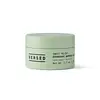What's inside
What's inside
 Key Ingredients
Key Ingredients

 Benefits
Benefits

 Concerns
Concerns

 Ingredients Side-by-side
Ingredients Side-by-side

Coco-Caprylate/Caprate
EmollientGlycerin
HumectantWater
Skin ConditioningAlmond/Borage/Linseed/Olive Acids/Glycerides
AntioxidantPolyglyceryl-6 Distearate
EmulsifyingJojoba Esters
EmollientOryza Sativa Starch
AbsorbentCetyl Alcohol
EmollientGlyceryl Stearate
EmollientHelianthus Annuus Seed Oil Unsaponifiables
EmollientGlyceryl Caprylate
EmollientPolyglyceryl-3 Beeswax
EmulsifyingSodium Stearoyl Glutamate
CleansingBenzyl Alcohol
PerfumingParfum
MaskingHippophae Rhamnoides Oil
EmollientTocopherol
AntioxidantMagnesium Carboxymethyl Beta-Glucan
Skin ConditioningDehydroacetic Acid
PreservativeEclipta Prostrata Extract
Skin ConditioningEclipta Prostrata Leaf Extract
Skin ConditioningMoringa Oleifera Seed Oil
EmollientHelianthus Annuus Seed Oil
EmollientRosmarinus Officinalis Leaf Extract
AntimicrobialCitronellol
PerfumingGeraniol
PerfumingLimonene
PerfumingLinalool
PerfumingCoco-Caprylate/Caprate, Glycerin, Water, Almond/Borage/Linseed/Olive Acids/Glycerides, Polyglyceryl-6 Distearate, Jojoba Esters, Oryza Sativa Starch, Cetyl Alcohol, Glyceryl Stearate, Helianthus Annuus Seed Oil Unsaponifiables, Glyceryl Caprylate, Polyglyceryl-3 Beeswax, Sodium Stearoyl Glutamate, Benzyl Alcohol, Parfum, Hippophae Rhamnoides Oil, Tocopherol, Magnesium Carboxymethyl Beta-Glucan, Dehydroacetic Acid, Eclipta Prostrata Extract, Eclipta Prostrata Leaf Extract, Moringa Oleifera Seed Oil, Helianthus Annuus Seed Oil, Rosmarinus Officinalis Leaf Extract, Citronellol, Geraniol, Limonene, Linalool
Water
Skin ConditioningPrunus Armeniaca Kernel Oil
MaskingLauryl Laurate
Skin ConditioningPolyhydroxystearic Acid
EmulsifyingStearyl Behenate
EmollientUndecane
EmollientGlycerin
HumectantPolyglyceryl-2 Dipolyhydroxystearate
Skin ConditioningTridecane
PerfumingPolyglyceryl-3 Diisostearate
EmulsifyingSaccharomyces Ferment
Skin ConditioningGarcinia Indica Seed Butter
Skin ConditioningMyristyl Myristate
EmollientPlatonia Insignis Seed Butter
EmollientHelianthus Annuus Seed Wax
Skin ConditioningTocopherol
AntioxidantPisum Sativum Extract
Skin ConditioningLauroyl Lysine
Skin ConditioningCaprylyl Glycol
EmollientGlyceryl Behenate
Emollient1,2-Hexanediol
Skin ConditioningMagnesium Sulfate
Ethylhexylglycerin
Skin ConditioningPotassium Sorbate
PreservativeSodium Benzoate
MaskingBenzyl Alcohol
PerfumingWater, Prunus Armeniaca Kernel Oil, Lauryl Laurate, Polyhydroxystearic Acid, Stearyl Behenate, Undecane, Glycerin, Polyglyceryl-2 Dipolyhydroxystearate, Tridecane, Polyglyceryl-3 Diisostearate, Saccharomyces Ferment, Garcinia Indica Seed Butter, Myristyl Myristate, Platonia Insignis Seed Butter, Helianthus Annuus Seed Wax, Tocopherol, Pisum Sativum Extract, Lauroyl Lysine, Caprylyl Glycol, Glyceryl Behenate, 1,2-Hexanediol, Magnesium Sulfate, Ethylhexylglycerin, Potassium Sorbate, Sodium Benzoate, Benzyl Alcohol
 Reviews
Reviews

Alternatives
Ingredients Explained
These ingredients are found in both products.
Ingredients higher up in an ingredient list are typically present in a larger amount.
Benzyl Alcohol is most commonly used as a preservative. It also has a subtle, sweet smell. Small amounts of Benzyl Alcohol is not irritating and safe to use in skincare products. Most Benzyl Alcohol is derived from fruits such as apricots.
Benzyl Alcohol has both antibacterial and antioxidant properties. These properties help lengthen the shelf life of products. Benzyl Alcohol is a solvent and helps dissolve other ingredients. It can also improve the texture and spreadability.
Alcohol comes in many different forms. Different types of alcohol will have different effects on skin. This ingredient is an astringent alcohol.
Using high concentrations of these alcohols are drying on the skin. They may strip away your skin's natural oils and even damage your skin barrier. Astringent alcohols may also irritate skin.
Other types of astringent alcohols include:
According to the National Rosacea Society based in the US, you should be mindful of products with these alcohols in the top half of ingredients.
Any type of sanitizing product will have high amounts of alcohol to help kill bacteria and viruses.
Learn more about Benzyl AlcoholGlycerin is already naturally found in your skin. It helps moisturize and protect your skin.
A study from 2016 found glycerin to be more effective as a humectant than AHAs and hyaluronic acid.
As a humectant, it helps the skin stay hydrated by pulling moisture to your skin. The low molecular weight of glycerin allows it to pull moisture into the deeper layers of your skin.
Hydrated skin improves your skin barrier; Your skin barrier helps protect against irritants and bacteria.
Glycerin has also been found to have antimicrobial and antiviral properties. Due to these properties, glycerin is often used in wound and burn treatments.
In cosmetics, glycerin is usually derived from plants such as soybean or palm. However, it can also be sourced from animals, such as tallow or animal fat.
This ingredient is organic, colorless, odorless, and non-toxic.
Glycerin is the name for this ingredient in American English. British English uses Glycerol/Glycerine.
Learn more about GlycerinTocopherol (also known as Vitamin E) is a common antioxidant used to help protect the skin from free-radicals and strengthen the skin barrier. It's also fat soluble - this means our skin is great at absorbing it.
Vitamin E also helps keep your natural skin lipids healthy. Your lipid skin barrier naturally consists of lipids, ceramides, and fatty acids. Vitamin E offers extra protection for your skin’s lipid barrier, keeping your skin healthy and nourished.
Another benefit is a bit of UV protection. Vitamin E helps reduce the damage caused by UVB rays. (It should not replace your sunscreen). Combining it with Vitamin C can decrease sunburned cells and hyperpigmentation after UV exposure.
You might have noticed Vitamin E + C often paired together. This is because it is great at stabilizing Vitamin C. Using the two together helps increase the effectiveness of both ingredients.
There are often claims that Vitamin E can reduce/prevent scarring, but these claims haven't been confirmed by scientific research.
Learn more about TocopherolWater. It's the most common cosmetic ingredient of all. You'll usually see it at the top of ingredient lists, meaning that it makes up the largest part of the product.
So why is it so popular? Water most often acts as a solvent - this means that it helps dissolve other ingredients into the formulation.
You'll also recognize water as that liquid we all need to stay alive. If you see this, drink a glass of water. Stay hydrated!
Learn more about Water